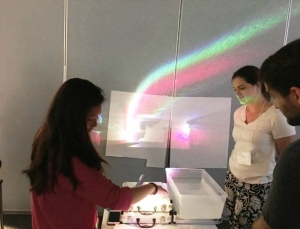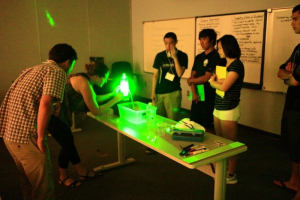For engineering graduate students bound for careers in academia, there’s probably no better honor than to be accepted into the Institute for Scientist & Engineer Educators (ISEE) Professional Development Program (PDP), a three-part series that teaches you how to teach, create a curriculum and then put it to work. And for graduate students like Gwen Musial, who aren’t yet sure if they’ll end up teaching or working in private industry, the program sure can turn your head.
“When I first thought about the award,” said Musial, a biomedical engineering (BME) Ph.D. candidate in the UH Cullen College of Engineering, “I thought it was great because learning to teach would also teach me to communicate in ways that people understand.” But after her three-part journey concluded in Maui, Hi., where she taught 29 students for a week, Musial has a slightly different take.
“I was going through the program with that lens, that I just wanted to learn how to communicate scientific information better, and the teaching was a secondary goal, but this definitely opened my eyes to teaching,” said Musial. “I was surprised how much I loved it, so I don’t know anymore. I don’t have a five-year plan now.”
Mission accomplished then for ISEE PDP. A new teacher may one day join your ranks, thanks in no small part to the UH, which became an ISEE chapter site in 2014.
Three-part harmony
For a program structure, the three parts work seamlessly. In March, Musial attended the Inquiry Institute in Monterrey, Ca. where, she says, she learned how people learn. It is a four-day series of workshops providing background in effective teaching.
Next came the Design Institute in Santa Cruz, Ca., a two-day workshop in which Musial and other participants designed science, technology, engineering and math (STEM) laboratory-style activities while focusing on equitable learning environments.
And then came the teaching. Luckily for Musial it was in Maui. That might make anyone want to become a teacher.
In the classroom
Musial and six other PDP participants taught the activities they designed to undergraduate students who would start an internship after taking her course. Musial’s curriculum involved the eyes, which is the area she focuses on in her research studies, conducted jointly at UH’s College of Optometry in Jason Porter’s laboratory.
“My team’s course was on light, conducting inquiry activities about how light behaves at interfaces like water and glass or air and water,” said Musial. That description is the definition of Snell’s Law, more commonly known as the law of refraction.
To bring that to life, Musial presented six real-world phenomena and had her students test their hypotheses on how these marvels occur. Case in point: Why do we need goggles to see underwater?
“They figured it out and yes, it has to do with Snell’s Law,” said Musial. “In this example, there is an air/eye interface and that’s how our eyes are designed, but when you go into water, which has a different refractive index than air, light doesn’t bend as much so it doesn’t form a point in the back of our eyes, so we get a blurry image. But if you put on goggles, you restore the air/eye interface.”
Sounds like a great teacher already. According to ISEE, creating these kinds of empowering learning experiences for students is exactly what they hope participants like Musial learn and carry forward in their careers.
“Dean Tedesco, Provost Short and I deeply care about the preparation of our students for a faculty position one days,” said Metin Akay founding chair and John S. Dunn Endowed Chair Professor of biomedical engineering. “Gwen’s selection and participation in this unique professional development event is very important.”
ISEE is headquartered at the University of California, Santa Cruz and receives funding by the National Science Foundation and others sources.

